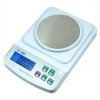Would it make
sense to Determine "Relative Densities" instead?
By that I mean take your Scale and then Measure (as Accurately and Precise) 1ml of each of your Ingredients. Pure VG, Pure PG, Nicotine Base, Flavoring. And then record your findings.
Or you could do the Math for the Theoretical Density.
1ml of Nicotine Base = (% of Nicotine x 1.015) + (% of PG x 1.036) + (% of VG x 1.261)
BTW - As a Check, Your Theoretical Nicotine Base Density should be in between 1.015 and 1.261. Because 1.015 is the Least Dense Component of the Nicotine Base. And 1.261 is the Most Dense Component.

